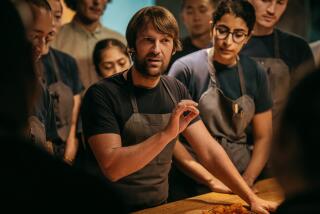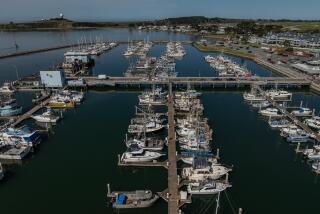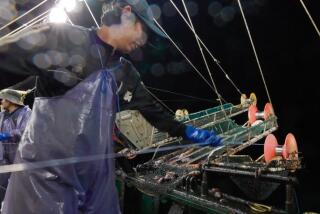Book review: âFour Fish: The Future of the Last Wild Foodâ by Paul Greenberg
Four Fish
The Future of the Last Wild Food
Paul Greenberg
The Penguin Press: 286 pp., $25.95
Didactic â however worthy â is not much fun. Ecological and planet-saving literature tends to argue for the essential. The discoveries, the questions, the issues it raises must exercise us. And exercise is an excellent thing. Only, in a contemporary contentiousness, that pits puritans against know-nothings, rather excluding play.
So much as preface to Paul Greenbergâs âFour Fish: The Future of the Last Wild Food.â He deals in weighty though never ponderous detail with such matters as the despoliation of our seas by industrial overfishing and the tension between the need to feed our world and to preserve it. He writes with evocative passion about the individual animal wildness of a bluefin tuna, a king salmon, an ocean-spanning cod.
More unusually, he goes on to convey what can only be called the fishermanâs happiness: part battle, part sense of primeval freedom in a constrained world. At 13, he got his hands on a used dinghy and taught himself to navigate and fish: â Long Island Sound still felt to me like wilderness â a place to freely search out and capture wild game. I thought of the sea as a vessel of desires and mystery, a place of abundance I did not need to question.â
The signal quality of Greenbergâs book is its genial and sometimes despairing struggle with contradiction. Not many who argue for our planetâs endangered species also write the thrill of hunting them. Like the fish he once hooked, he plunges away and is reeled back. âFour Fishâ is a serious and searching study. Written with wit and beauty, it is also play.
The book is divided into chapters devoted respectively to salmon, sea bass, cod and tuna: the four most prized by consumers and, as a result, suffering drastic reductions in their wild stock. Each section describes roughly the same cycle. There were the times of abundance, when fish found rich prey and nutrients and could freely follow vast patterns of migration. Then came pollution and changes in water temperatures, along with the blocking of essential spawning routes. The Connecticut River, for instance, was spawning ground for salmon multitudes until the 18th century construction of dozens of small energy-producing dams closed it off.
Greenberg writes of the drastic decrease of wild populations, the depredations of industrial fishing and the uncertain efforts to slow the decline by setting catch limits and closing some traditional grounds. Striped bass, which had almost vanished from American coastal waters, have been partly restored. There has been some regeneration of cod with the management efforts at Canadaâs Grand Banks and Maineâs Georges Bank, but the effort is painfully slow.
The author has written vivid portraits of innovators in the effort to deal in different ways with the growing scarcities. There is Jac Gadwill, who runs an enterprise along the Yukon River in Alaska that tries to help the Yupâik people to maintain their precarious life by catching strictly limited quantities of wild salmon and marketing the catch to expensive U.S. restaurants. There is Maine fisherman Ted Ames, who won a MacArthur âgeniusâ grant by encouraging local groups of cod fishermen to âherdâ their cod populations by devising their own limits and conservation practices.
Greenberg examines fish farming, which accounts for most of the salmon and sea bass now sold. He details the efforts, only partly successful, to deal with the problems it has raised: pollution, genetic contamination that threatens the wild species and the much-debated question of flavor. Unregulated farming has debased standards in some parts of the world; in Europe, sea bass has lost some of its status as a premium fish.
He acknowledges that mounting food demand is inevitable; the worldâs per capita consumption of fish has increased from 20 pounds in the 1960s to 36 pounds today. The solution must be fish farming, he reluctantly concedes; otherwise, the pressure on wild stock will be uncontainable.
He argues, though, that farming should shift from the four premium fish, where it squeezes the wild population, to other species. Tilapia, for example, breed in fresh water, multiply rapidly and live on a vegetarian diet, thus reducing the need for the industrial harvesting of the tiny marine life that salmon, cod, bass and tuna require.
Clearly, Greenbergâs humane passion is on the side of wild fish; in the case of the bluefin tuna he calls for the kind of ban that has been applied to whales. Let the worldâs need for fish be met by the likes of tilapia and similar unglamorous species. If drastic limits on wild fish mean premium prices and luxury status, all the better.
âWild fish did not come into this world just to be our food,â he argues. âThey came into this world to pursue their own individual destinies. If we hunt them and eat them, we must hunt them with care and eat them with the fullness of our appreciation. We must come to understand that eating the last wild food is, above all, a privilege.â
Eder, a former Times book critic, was awarded a Pulitzer Prize for criticism in 1987.
More to Read
The biggest entertainment stories
Get our big stories about Hollywood, film, television, music, arts, culture and more right in your inbox as soon as they publish.
You may occasionally receive promotional content from the Los Angeles Times.










